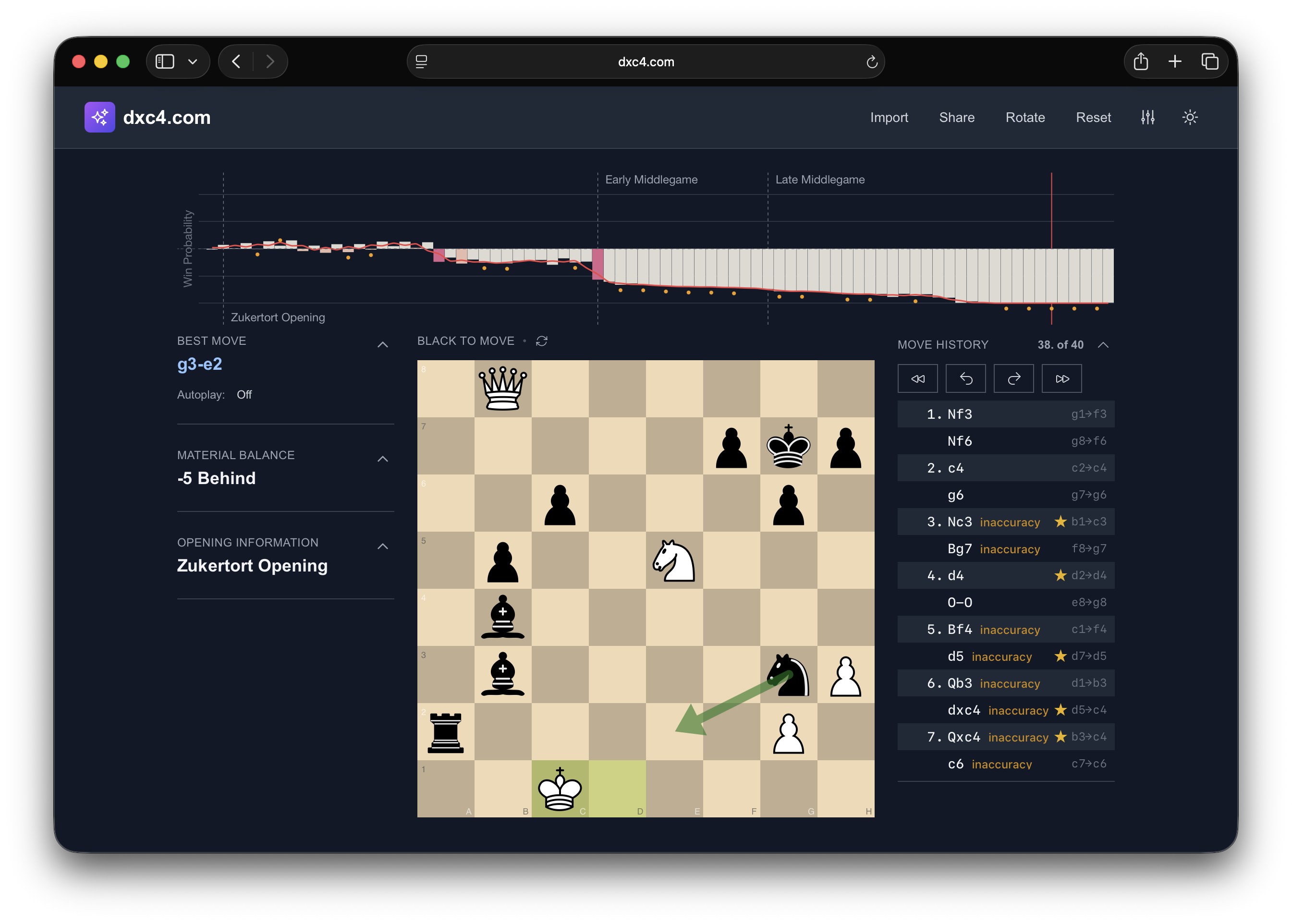I’ve always taken notes when reading non-fiction—distilling insights into simple, actionable principles. A few years ago, I set out to improve my chess and read several books, with The Amateur’s Mind by Jeremy Silman standing out most.
My notes included a list of essential principles. By following these I saw a solid boost in my own strength (on a rather low level, mind you).
While on vacation, I didn’t have my notebooks with me—but I managed to reconstruct the core ideas with a little help from memory and a few prompts (and yes, a little AI).
Table of Contents
- Opening Principles
- Middlegame Strategy
- Endgame Strategy
- How to Think on Every Move
- Common Mistakes to Avoid
- Time-Phase Mental Models
1. Opening Principles
The opening phase begins when pieces are still on their starting squares and ends when both sides have completed development and castled. Focus on rapid development, king safety, and establishing a solid foundation for the middlegame.
- Control the center – Use pawns (e4/d4) and pieces to dominate central squares.
- Develop minor pieces early – Knights and bishops before queen and rooks.
- Don’t move the same piece twice – Unless forced or highly justified.
- Don’t bring your queen out early – Avoid getting chased and losing tempo.
- Castle early – Secure your king and connect rooks.
- Avoid excessive pawn moves – Focus on piece development.
- Develop with threats if possible – Gain time by forcing reactions.
- Connect your rooks – Complete development by moving the queen off the back rank.
- Protect your king’s pawn cover – Don’t weaken it unnecessarily.
- Know common traps – Avoid cheap mates and openings tricks.

2. Middlegame Strategy
The middlegame begins after both sides have developed and castled, and continues until most pieces are traded. This is where plans are executed, tactics are found, and the battle for positional advantages takes place. Use the evaluation framework in section 4 to guide your decision-making.
- Improve the worst-placed piece – Seek active squares.
- Look for tactics – Pins, forks, skewers, discovered attacks.
- Coordinate pieces – Ensure your pieces work together.
- Control open files – Especially with rooks.
- Use outposts – Knights on protected advanced squares are powerful.
- Trade when ahead – Simplify to convert an advantage.
- Exchange imbalance awareness – Consider position—not just material balance.
- Don’t rush attacks – Prepare before launching.
- Avoid pawn weaknesses – Doubled, isolated, or backward.
- A locked center calls for play on the wings - an open center favors quick piece activity.
3. Endgame Strategy
The endgame begins when most pieces have been traded and the kings become active fighting pieces. This phase emphasizes king activity, pawn promotion, and precise calculation to convert advantages into wins.
- Activate the king – It’s a fighting piece now.
- Push passed pawns – Especially with support.
- Cut off the enemy king – Rook endgames especially.
- Use opposition – Especially in king + pawn endgames.
- Rook behind the passed pawn – Yours or theirs.
- Trade pieces, not pawns – If trying to draw.
- Centralize remaining pieces – Especially the king.
- Convert slowly but accurately – Avoid blunders.
- Avoid stalemates – Don’t give away draws when winning.
4. How to Think on Every Move
10-step checklist during your thinking process to evaluate any position and select the best move. Go through each step systematically, especially in critical positions.
-
Safety First
- Is my king safe?
- Are any pieces under threat?
- Can I be checkmated or forked?
-
Tactical Scan
- Are there checks, captures, or threats?
- Look for pins, forks, skewers, and discoveries.
-
Opponent’s Plan
- What does their last move threaten?
- What would they play next if it were their turn?
-
Piece Activity
- Which piece is worst? Can I improve it?
- Can I coordinate pieces better?
-
Pawn Structure
- Any weak pawns (doubled, isolated, backward)?
- Can I create a break or passed pawn?
-
Space & Control
- Who controls the center or key files?
- Can I seize or contest open lines?
-
Trade or Keep?
- Trade when ahead; avoid trades when behind.
- Don’t trade active for passive pieces.
-
Strategic Plan
- Do I have a clear goal (attack, defend, convert)?
- Is my move furthering that plan?
-
Candidate Moves
- Generate 2–3 solid options.
- Compare them based on above criteria.
-
Sanity Check
- Re-scan the board for blunders.
- Double-check threats, especially before committing.
- Look one move ahead for every move you consider – e.g. “If I play this, what’s their best reply?“
5. Common Mistakes to Avoid
Review this list before and after games to identify patterns in your play. These are the most frequent errors that cost intermediate players games and rating points.
- Hanging pieces – Always check for undefended pieces.
- Hope chess – Don’t make moves hoping for mistakes.
- Overextending – Don’t push pawns too far without support.
- King neglect – Don’t delay castling or weaken pawn shelter.
- Ignoring opponent’s plan – React as well as act.
- Bad trades – Don’t swap active pieces for passive ones.
- Tunnel vision – Always scan the whole board.
- Tempo waste – Don’t make non-developing or repetitive moves.
- Over-relying on traps – Tricks work occasionally, strategy works always.
- Clock misuse – Don’t blitz or freeze at critical moments.
6. Time-Phase Mental Models
Use this table to adjust your thinking based on the current game phase. Each phase requires different priorities and questions to guide your decision-making process.
| Phase | Ask Yourself |
|---|---|
| Opening | How do I develop fast and safely? |
| Early Middlegame | What weaknesses can I exploit? |
| Middlegame | What is my long-term plan? |
| Late Middlegame | Simplify or complicate? |
| Endgame Transition | Who has the better long-term chances? |
| Endgame | How do I promote (or stop promotion)? |
| Balanced/Equal | Look for small advantages to press—space, better bishop, safer king. |
| Winning | What’s the cleanest conversion path? |
| Losing | Can I complicate, trap, or draw? |
